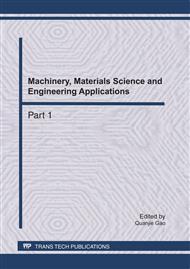p.1057
p.1063
p.1070
p.1075
p.1080
p.1085
p.1089
p.1094
p.1100
Body Welding Quality Control Based on a CUSUM Control Chart
Abstract:
Aiming at the situation in some Chinese auto companies that the workload of body welding quality inspection is high and the sample size is extremely small, a brand-new CUSUM Control Chart for variance monitoring is proposed in the paper to realize the effective quality control in body welding variance, whose principle is to use variance statistics based on Queensberry transformation Φ-1(G((n-1) St2/σ02)) to monitor infinitely small variances in the process of body welding. Evaluation instance results show that, compared with traditional CUSUM control chart, EWMA control chart and weighted CUSUM control chart, the proposed CUSUM control chart based on variance monitoring is more sensitive to the abnormal variation fluctuation and can detect the abnormity of quality variation earlier.
Info:
Periodical:
Pages:
1080-1084
Citation:
Online since:
April 2011
Keywords:
Price:
Сopyright:
© 2011 Trans Tech Publications Ltd. All Rights Reserved
Share:
Citation:


